The English text is in YELLOW, the Italian text (original) is in GREEN.
Questa e` la prima pubblicazione di Gnarlydog News bilingue, cortesia di Marco Ferrario.
Il testo in VERDE e` in Italiano
KAYAKER’S EAR – L’ORECCHIO DEL KAYAKER
Rolling and tinnitus - Eskimo ed acufene
Il kayaker appassionato di rolling (eskimo) è un soggetto a rischio di acufene (tinnitus)?
Forse molti kayakers si chiederanno cosa centrano gli acufeni con il kayak da mare, ebbene ...
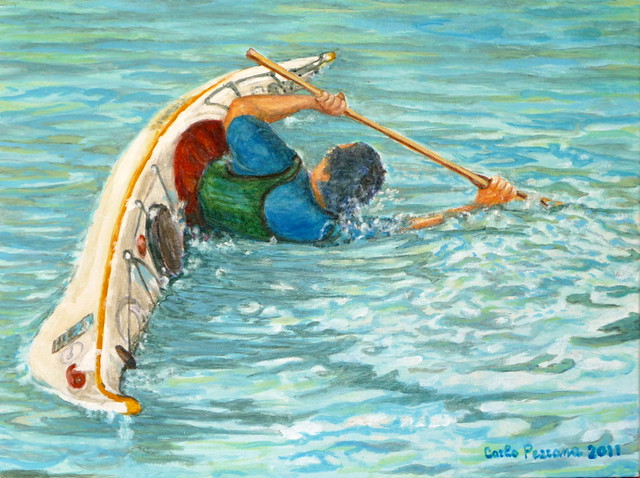
Image of KayArt - di Carlo Pezzana (http:/www.kayart.it)
Nel 1996 feci il mio primo corso di eskimo (rolling) in piscina.
Dopo le prime lezioni iniziai ad eseguire stentatamente i primi miei eskimo senza l’aiuto dell’istruttore.
Con soddisfazione avevo compiuto i primi passi verso questa divertente tecnica di auto-salvataggio.
Negli anni seguenti, provai più volte ad eseguire l’eschimo in mare, ma non sempre con successo , la mia esecuzione era ancora scadente.
Così, nell’inverno 2001-2002, per migliorarmi, tornai in piscina, che era a disposizione dei kayakers per una sera a settimana, per un paio d’ore.
Il divertimento e la soddisfazione nell'eseguire la manovra dell'eskimo, mi spingeva a provare e riprovare molte volte, continuativamente.
Per eseguire l’eskimo (rolling), dalla posizione seduta in kayak, si entra in acqua su un fianco, eseguendo un “piccolo tuffo” laterale, impattando contro la superficie dell’acqua.
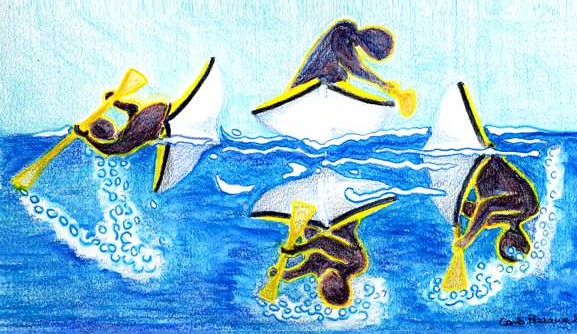
Image of KayArt - di Carlo Pezzana (http://www.kayart.it)
The kayaker keen on rolling (Eskimo) is a subject at risk of tinnitus?
Perhaps many will wonder what kayakers and tinnitus have in common with sea kayaking; well ...
In 1996 I took my first kayak rolling course in the pool.
After the first lessons I started to run my first haltingly roll without the help of the instructor.
With satisfaction I had taken the first steps towards this fun technique of self-rescue.
In the following years, I tried several times to roll at sea but not always successfully, my
The kayaker keen on rolling (Eskimo) is a subject at risk of tinnitus?
Perhaps many will wonder what kayakers and tinnitus have in common with sea kayaking; well ...
In 1996 I took my first kayak rolling course in the pool.
After the first lessons I started to run my first haltingly roll without the help of the instructor.
With satisfaction I had taken the first steps towards this fun technique of self-rescue.
In the following years, I tried several times to roll at sea but not always successfully, my
performance was still poor.
Thus, in the winter of 2001-2002, to improve myself, I returned to the pool, which was available to kayakers one night a week, for a couple of hours. The fun and satisfaction in performing a roll pushed me to try again and again many times, continuously. To perform a roll, while sitting in a kayak, you enter the water on one side, performing a "little side dive", impacting against the surface of the water.
Thus, in the winter of 2001-2002, to improve myself, I returned to the pool, which was available to kayakers one night a week, for a couple of hours. The fun and satisfaction in performing a roll pushed me to try again and again many times, continuously. To perform a roll, while sitting in a kayak, you enter the water on one side, performing a "little side dive", impacting against the surface of the water.
Il mio corpo entrava ed usciva dall'acqua e, una volta sott’acqua, rimanevo per alcuni secondi a testa
capovolta, prima di completare l’eskimo. Il fastidio dell’acqua nelle orecchie e nel naso era sopportabile, perciò non utilizzavo tappi per le orecchie e alcune volte non mettevo neanche la molletta per chiudere il naso. All’uscita dalla piscina, con la testa forse ancora un poco umida, percepivo tutto il gelo della serata invernale con temperature inferiori agli 0° centigradi e spesso avevo la sensazione di avere le orecchie chiuse e piene d'acqua. A volte l’udito, per i primi minuti, era ovattato e rimbombante, poi le orecchie si stappavano e il problema si risolveva, perciò non ho mai dato molta importanza a questo disturbo passeggero.
Una sera, tornato a casa, non riuscii più a liberarmi della sensazione di acqua nelle orecchie.
Scuotevo la testa e mi schiaffeggiavo le tempie, ma nulla, le orecchie rimanevano tappate e persisteva la sensazione di avere ancora acqua nel loro interno.
In questa condizione rimasi per alcuni giorni, passati i quali, iniziai a percepire un miglioramento, l'orecchio si stava finalmente liberando dall'acqua, ma, alla sensazione di essersi liberati, si sostitui presto un costante piccolo fruscio. Inizialmente la sensazione fu che il fruscio provenisse dall’ambiente, ma presto mi resi conto che proveniva dalle mie orecchie.
Avevo l’impressione che un insetto sia entrato nel mio condotto uditivo e, sbattendo disperatamente le ali, non riusciva più ad uscire.
Da allora, l'alta tonalità dell'acufene non mi ha più lasciato, lo sento sempre, costantemente e, nel tempo,
è aumentata l'intensità del rumore percepito.
Lo sento nelle orecchie ma sembra che si estenda anche nella parte alta del cervello.
My body would enter and exit from the water, and once under water, woudl remaini for a few seconds head
upside down, before completing the roll. The discomfort of the water in the ears and nose was bearable, so I did not use ear plugs and sometimes would not even put on the clip to close the nose.
Walking away from the pool, my head maybe a little wet, I felt every chill of winter evening with temperatures below 0 ° Celsius often feeling my ears closed and full of water. Sometimes the hearing, for the first few minutes, was muffled, rumbling, then the ears uncorked, and the problem was solved; so I never gave much importance to this passing discomfort. One evening, returning home, I could no longer get rid of the feeling of water in the ears. I shook my head and tapped the sides, but nothing: the ears remained plugged and the persisting feeling of having more water in them.
I remained for several days in this condition, after which I began to feel an improvement: the earwas finally releasing the water. But the feeling of getting rid of it was soon replaced by a constant
small noise, sensing that initially the noise came from the environment, instead I soon realized
it came from my ears. I had the impression that an insect has entered into my ear canal and, flapping frantically its wings, could not get out.
Since then, the high-pitched tinnitus hast never left me, I always hear it, constantly, and over time has increased in the intensity of perceived noise.
I feel it in my ears but it seems that it also extends into the upper part of the brain.
Mi sottoposi ad una sequenza di visite in centri specialistici otorinolaringoiatrici e audiologici, i medici mi prescrissero diversi esami, che feci regolarmente, ma che non mi permisero di capire come intervenire per risolvere il mio disturbo. Gli esami esclusero determinate patologie.
Più specialisti contattavo e più mi convincevo che nessuno poteva offrirmi una soluzione certa.
La risonanza magnetica e la Tac esclusero problematiche ancora più serie.
Feci anche qualche tentativo di cura, ma senza successo, perciò mi rassegnai, sforzandomi di convivere con questo fastidioso rumore.
Image of KayArt - di Carlo Pezzana (http://www.kayart.it)Sono trascorsi ormai molti anni, il suono dell'acufene è aumentato rispetto al periodo iniziale e si è anche
differenziato arricchendosi di nuove tonalità, sempre molto acute.
A volte assomiglia ad uno scroscio d'acqua, come fosse un rubinetto aperto, altre volte è un suono a metà strada tra una sirena e un fischio e l’impressione è che il timpano stia vibrando in continuazione.
L'udito ne risente sempre più (ipoacusia), come anche lo stress conseguente.
In questi anni mi sono informato e ho avuto modo di constatare che tra i soggetti più frequentemente a rischio d’acufene, c'è chi pratica sport acquatici o li ha praticati in passato, perciò i surfisti, i nuotatori, i tuffatori, chi pratica bodybording, kitesurf e chi, facendo immersioni, ha accusato problemi di compensazione.
Kayakers fluviali, hanno iniziato a soffrire di acufeni dopo un bagno in acque fredde, anche se indossavano il casco, che attutisce l'impatto con l'acqua.
A chi gli acufeni sono passati, ho l'impressione che sia stata più una casualità, piuttosto che una specifica cura. La maggioranza di chi ne soffre, ha imparato, necessariamente, a convivere con questi rumori persistenti.
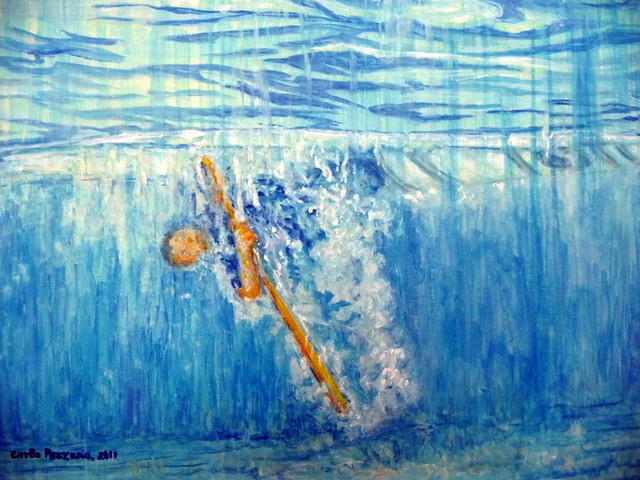
Imagee of KayArt - di Carlo Pezzana (http://www.kayart.it)
I started a sequence of visits to specialist centers and ENT doctors prescribed me different
exams, which I did regularly, but that did not allow me to understand how to intervene to solve my trouble. exams
ruled out certain diseases.
The more specialist I contacted the more I was convinced that no one could offer a reliable solution.
MRI and CAT scan ruled out more serious problems.
I also made some attempts to cure, but without success, so I resigned myself, trying to live with
this annoying noise.
exams, which I did regularly, but that did not allow me to understand how to intervene to solve my trouble. exams
ruled out certain diseases.
The more specialist I contacted the more I was convinced that no one could offer a reliable solution.
MRI and CAT scan ruled out more serious problems.
I also made some attempts to cure, but without success, so I resigned myself, trying to live with
this annoying noise.
It has been many years; the sound of tinnitus has increased compared to the initial period and it is also
differentiated enriched with new shades, always very acute.
At times resembling a roar of water, like a tap running, other times it sounds somewhere between a siren and a whistle, and the impression is like that the eardrum is vibrating constantly.
My hearing is affected (hearing loss), as well as the resulting stress.
All these years that I have gathered information and my observations have lead that among those most frequently at risk of tinnitus are those who practice water sports or practiced them in the past. So surfers, swimmers, divers, bodyboarders and kitesurfers, scuba diviners, lament Compensation Issues.
River kayakers began to suffer from tinnitus after a dunk in cold water, even if they wore a helmet, which dampens the impact with the water.
differentiated enriched with new shades, always very acute.
At times resembling a roar of water, like a tap running, other times it sounds somewhere between a siren and a whistle, and the impression is like that the eardrum is vibrating constantly.
My hearing is affected (hearing loss), as well as the resulting stress.
All these years that I have gathered information and my observations have lead that among those most frequently at risk of tinnitus are those who practice water sports or practiced them in the past. So surfers, swimmers, divers, bodyboarders and kitesurfers, scuba diviners, lament Compensation Issues.
River kayakers began to suffer from tinnitus after a dunk in cold water, even if they wore a helmet, which dampens the impact with the water.
In those cases where the tinnitus is gone, I feel that it's been more of chance, rather than a specific care.
The majority of sufferers have learned, by necessity, to live with these persistent noises.
The majority of sufferers have learned, by necessity, to live with these persistent noises.
C'è poi chi afferma di aver eliminato l'acufene dopo una terapia intensiva, durata diversi mesi, con un potente antiossidante ad azione neurotrofica. Altri dicono che si può provare con l'agopuntura. Alcuni hanno provato ad utilizzare, come palliativo, apparecchi acustici che rilasciano un suono mascheratore, che dovrebbe essere l'eguale-contrario al suono dell'acufene percepito e pertanto dovrebbe annullarne il rumore originario, ma tra chi ha adottato questi apparecchi, non conosco nessuno che ha veramente risolto definitivamente il problema. Un medico mi ha detto che in America è possibile intervenire chirurgicamente, ma l’intervento è molto costoso e rischioso, in quanto può provocare facilmente la perdita totale dell'udito. Una volta verificato che l'acufene non è un problema di cerume nell'orecchio e dopo e dopo aver fatto gli esami che escludono le cause extraotogene (cioè malattie che non dipendono dall'orecchio), i medici pensano che la causa del mio acufene sia dovuta a una deformazione o inspessimento o spostamento di un ossicino dell’orecchio, problema causato molto probabilmente da una esposizione all'acqua e, contemporaneamente, al freddo. Sta di fatto che nessun medico è in grado di garantirmi la guarigione, al punto che sono ormai dell'idea che non mi libererò mai più dall'acufene e credo che presto sarò costretto a cercare una soluzione per migliorare il mio udito, che nel tempo si è decisamente ridotto.
There are some who claim to have eliminated the tinnitus after an intensive period of several months, with a powerful neurotrophic with antioxidant action.
Others say to try acupuncture. Some have tried to use, as palliative care, hearing aids that emit a masking sound, which would be exact contrary to the perceived tinnitus sound, and therefore should cancel the original noise. Between those who adopted these devices, I do not know of anyone who has really solved definitely the problem. A doctor told me that in America you can perform surgery, but surgery is very expensive and risky as it can easily lead to total hearing loss.
Once I have verified that tinnitus was not a problem of earwax in the ear and after carring out many tests that would excluded external factors (ie diseases that do not depend on the ear), the doctors think that the cause of my tinnitus is due to a thickening, deformation or displacement of an ear bone, a problem most likely caused by the exposure to water and at the same time to cold.
The fact is that no doctor is able to guarantee me the healing, to the point that they are now of the idea that I will never rid myself from tinnitus and I think that soon I will be forced to seek a solution to improve my hearing, that over time has significantly reduced.
Others say to try acupuncture. Some have tried to use, as palliative care, hearing aids that emit a masking sound, which would be exact contrary to the perceived tinnitus sound, and therefore should cancel the original noise. Between those who adopted these devices, I do not know of anyone who has really solved definitely the problem. A doctor told me that in America you can perform surgery, but surgery is very expensive and risky as it can easily lead to total hearing loss.
Once I have verified that tinnitus was not a problem of earwax in the ear and after carring out many tests that would excluded external factors (ie diseases that do not depend on the ear), the doctors think that the cause of my tinnitus is due to a thickening, deformation or displacement of an ear bone, a problem most likely caused by the exposure to water and at the same time to cold.
The fact is that no doctor is able to guarantee me the healing, to the point that they are now of the idea that I will never rid myself from tinnitus and I think that soon I will be forced to seek a solution to improve my hearing, that over time has significantly reduced.
Che dire ancora?
Ecco qualche suggerimento, dettato dalla mia esperienza, nella speranza possa essere utile a prevenire
l'acufene negli appassionati di kayak e di eskimo (rolling).
Certezze non ne ho e non ho una cultura medica, ma, da kayaker, consiglierei di non eseguire l'eskimo senza dei buoni tappi nelle orecchie e una molletta stringi naso, per ottenere un sigillo totale. Orecchio e naso sono collegati e perciò l'acqua che entra dal naso raggiunge il timpano e l'orecchio medio, credo sia opportuno tappare entrambi.
Queste precauzioni sono tanto più importanti, quanto l’acqua e/o la temperatura esterna è fredda.
Le orecchie vanno protette anche in caso di forte vento e in particolare in caso di vento gelido.
Conoscere e confrontare le esperienze potrebbe essere molto utile.
E’ necessario sapere quali sono i rischi per le orecchie del kayaker, per prevenire l’acufene; e conoscere i rimedi efficaci, se esistono, per chi ne è affetto.
N.B. - quando pagaio, come quando sono molto concentrato a svolgere con passione qualche lavoro, pur essendo l'acufene sempre presente, non ci penso e lo percepisco meno, mentre ora che ne sto parlando, anzi scrivendo, raccontandolo, il tinnitus è fortissimo.
Un saluto con pagaia.
Marco
(Eko) http://ekokayak.wordpress.com
ekokayak@gmail.com
ekokayak@gmail.com
What else can I say?
Here are some suggestions, derived from my experience in hope they will be useful to prevent
tinnitus in kayakers and rollers.
I don't have certainties or medical knowledge, however, as kayaker, I recommend not to roll without some good earplugs and a tight nose clip , to obtain a total seal. Ear and nose are connected and therefore the water that comes from the nose reaches the eardrum and middle ear, I believe both.must be stopped.
These precautions are even more important when water and /or the outisde temperature is cold.
The ears should be protected even in windy conditions, especially in freezing wind. To know and compare the experiences could be very useful. And 'need to know what are the risks to the ears of the kayaker to prevent tinnitus; and know the effective remedies, if any, for those affected.
NB - When I paddle, as when I am very passionately focused with a job, while the tinnitus being always present, and I do not think about it and I feel it less, but now that I'm talking about, even writing, describing it, tinnitus is very strong.

photo by Marco Ferrario, publisher of Ekokayak on a trip in Sardegna
This article was translated with Google Translate with additional corrections.
Here are some suggestions, derived from my experience in hope they will be useful to prevent
tinnitus in kayakers and rollers.
I don't have certainties or medical knowledge, however, as kayaker, I recommend not to roll without some good earplugs and a tight nose clip , to obtain a total seal. Ear and nose are connected and therefore the water that comes from the nose reaches the eardrum and middle ear, I believe both.must be stopped.
These precautions are even more important when water and /or the outisde temperature is cold.
The ears should be protected even in windy conditions, especially in freezing wind. To know and compare the experiences could be very useful. And 'need to know what are the risks to the ears of the kayaker to prevent tinnitus; and know the effective remedies, if any, for those affected.
NB - When I paddle, as when I am very passionately focused with a job, while the tinnitus being always present, and I do not think about it and I feel it less, but now that I'm talking about, even writing, describing it, tinnitus is very strong.

photo by Marco Ferrario, publisher of Ekokayak on a trip in Sardegna
This article was translated with Google Translate with additional corrections.

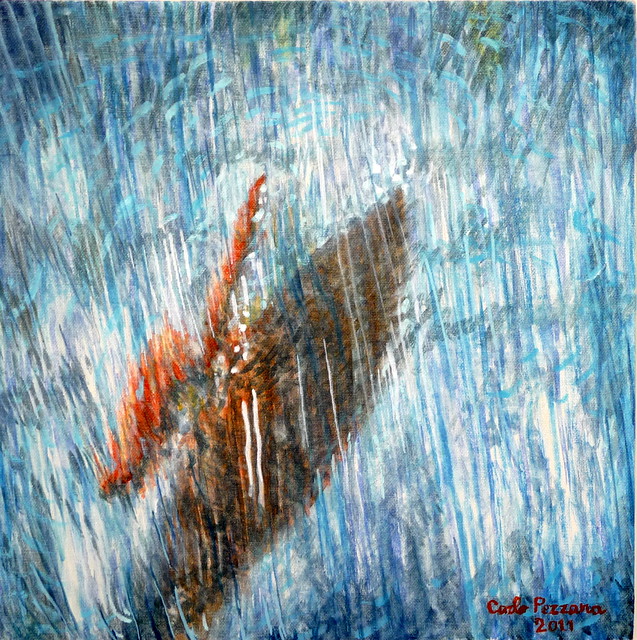
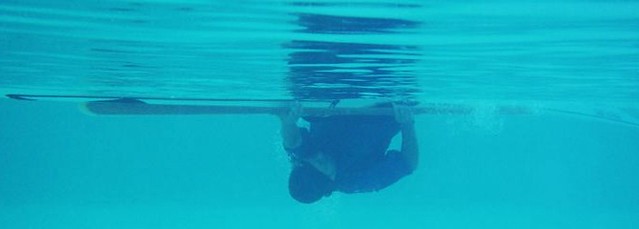


Really interesting post!
ReplyDeleteI suffer from tinnitus... although i'd love to blame years of diving in cold Tassie waters, i reckon it might've been my earlier years of audio engineering.
Although, i must say, i've had that 'water-in-the-ears' sensation several times from diving and kayaking and every time i felt like my tinnitus and hearing got worse.
Anyway, really interesting stuff for people to keep in mind! Good one.
Interesting stuff and some nice art! ;)
ReplyDeleteBeing a diving instructor and technical diver for years, I've never had any problems with that. But I will keep it mind now and will use some ear-plugs for training-sessions.
Thanks for this post...
Really enjoyed the post and will certainly take heed in the future especially up here in the cold atlantic waters of NL. Also enjoyed the KayArt. Best of paddling downunder Gnarly!
ReplyDeleteHi Marco
ReplyDeleteI was very interested to read your story as I am currently studying the use of manual trigger point therapy on various conditions, including tinnitus as part of a diploma of remedial massage.
This condition is also common in older folk who are not water people.
An older family friend has this condition and has found some relief with trigger point therapy on the deep masseter muscle (powerful muscle that chews food and clenches teeth) and the SCM muscle (rotates and flexes head).
When she is stressed and her breathing pattern becomes more rapid and higher up in her chest, her symptoms increase. The SCM is a muscle used for inhalation, so it makes sense to me to relax that muscle to relieve the symptoms.
It’s an extremely frustrating condition, I hope you can find some relief soon Marco.
Good luck with the research.
Tess
received as email:
ReplyDelete> Ciao
> Ahimè!!Anch'io soffro di questo fastidioso disturbo all'orecchio sinistro da circa tre anni.
> Nel mio caso do la colpa al vento,è una mia ipotesi,non ho riscontri oggettivi,non ho mai fatto esami,vuoi perchè sono un po' superficiale,vuoi perchè sono anche un po' ipocondriaco.
> Ho chiesto a due amici medici(canoisti)del nostro Canoa Club,entrambi mi hanno risposto:vuol dire che ti pensano.
> Scherzi a parte le loro risposte:prendi questo,prova con questo,fai degli esami...ecc..ecc..
> Marco:ho imparato a conviverci,il giorno non ci faccio più caso,ma la sera quando vado a dormire,complice il silenzio,il fischio è continuo finchè non mi addormento,raramente non compare.
> Ti dicevo del vento,ricordo di due uscite consecutive in montagna,entrambe con un fortissimo vento,e alcune uscite in canoa sempre nei giorni susseguenti,sempre con forte vento.
> Sarà un caso, ma dopo non molto ho iniziato ad avere questo problema.
> Per quanto concerne l'udito non credo che me lo abbia pregiudicato,ci sento bene anche se a volte mia moglie e le mie due figlie mi dicono:ma sei sordo?!!
> Scusami se mi sono dilungato troppo.
> Buona giornata e buone pagaiate nonostante i fischi.
>
> Carlo
Google translated:
DeleteHello
Alas! I too suffer from this annoying noise in the left ear for about three years now.
In my case I blame the wind, it is my hypothesis, I have no objective evidence, I have never done exams, maybe because I am a little superficial or maybe because I am a little hypochondriac.
I asked two medical friends of mine (canoeists) form our Canoe Club, both of which have replied to me meaning that they care about you.
Jokes aside, their answers: take this, try this, do the exams ... etc. .. etc. ..
Marco, I have learned to live with it, during the day I do not notice it, but when I go to sleep at night, aided by the silence, the whistle is continuous until I fall asleep; it rarely doesn't appear.
About the wind, I remember two consecutive outings to the mountains, both with a strong wind, and some canoeing in the following days always, always with a strong wind.
Mighty be a coincidence, but before long I started having this problem.
As for my hearing, I do not think it has affected me, I feel good even though sometimes my wife and my two daughters say: Are you deaf?!!
I'm sorry if I have dwelt too long.
Good day and have a good paddle despite the whistles
received as email:
ReplyDelete>> Ciao Marco,
>> grazie per l'interessante articolo bilingue coi bei disegni di Carlo Pezzana.
>> Proprio oggi sono stata da un osteopata (guarda caso, canoista, oggi da onda)
>> che mi ha fatto un trattamento. Sentivo all'orecchio sinistro come un friggere-prurito
>> profondo per cui non posso fare nulla. Quest'estate, nei vari eskimi col mio skin-on-frame
>> qajaq autocostruito, mi sono distratta dimenticando di mettermi il tappanaso.
>> Dopo tanti anni, mi è ritornata la sinusite e con essa problemi all'orecchio sn.
>> Mi domando: ma persone che fanno dei rolling una professione, come fanno?
>> Conosciil G-style coi suoi 35 diversi rolling, aperto a nuovi...
>> Maligiaq Padilla, Dubside, Cheri Perry, Helen Wilson...e tantissimi nel mondo, non hanno
>> alcuna conseguenza. Come fanno?
>> Un caro saluto
>> Luisella
Hello Marco,
Thanks for the interesting bilingual article with the beautiful drawings of Carlo Pezzana.
Just today I went to an osteopath (coincidentally, canoeist, not surf)
I had a treatment. I felt in my left ear like a frying-itch feeling that I can do nothing about.
This summer, when rolling with my skin-on-frame DIY Qajaq, inadvertedly I forgot to wear the nose-clip.
After so many years, I regained sinus and ear problems.
I wonder what professional rollers do? You know: G-style, with its 35 different rolls, and counting
Maligiaq Padilla, Dubside, Cheri Perry, Helen Wilson ... and many others that have no ill effects. How do they do it?
Best wishes
Luisella
Gnarlydog,
ReplyDeletean interesting article here re. surfers ear in playboaters, major impact due to cold water ingress.
http://www.ukriversguidebook.co.uk/reports/general/when-good-ears-go-bad
When I was in NZ Mick Hopkinson who has had his ears drilled (- the worst pain ever he said!) he went to a specialist re ear protection, he paid $150 and was recommended Bluetac - effective, mouldable & cheap to chuck out /lose. Also the use of Earwigs, Reed type thin hoodies. In SEQ we would wear these as the wetness arose else our heads would cook!! I have some element of Exstosis in one of my ears, so on a wet day / WW trip I use blue tac.
Alan
additional info from Luisella:
ReplyDeleteConfermo che se si usa il tuilik della Reed, non entra acqua nelle orecchie
> se ci si ricorda di usare il tappanaso o il mascherino che copre anche il naso.
> Il tuilik ha la cuffia che stringe bene la testa includendo tutto eccetto gli occhi, il naso, la bocca
> (il mento può essere coperto stringendo le cordicelle della cuffia che poi girano dietro la nuca e si annodano.
> Appena posso passerò la domanda anche agli amici giapponesi che si dilettano a fare gli eskimi del
> G-roll nel ghiaccio dei loro laghi! sono curiosa di sapere, ammesso che me lo dicano (sono molto
> riservati i giapponesi), come stanno le loro orecchie e se soffrono di sinusite o
> Ciao
> Luisella
I confirm that if you use the tuilik Reed, water does not enter the ears if you remember to use the nose clip or mask that also covers the nose.
The tuilik has an inclusive hood that seals well except the eyes, nose, mouth (the chin may be covered by tightening the cords of the hood then turned around the neck and knotted behind).
As soon as I can I will forward the query also to my Japanese friends who delight at rolling in the ice of their lakes! I'm curious to find out, if I they will tell me (the Japanese are very
reserved) how are their ears and if you suffer from sinusitis
Ciao
Luisella
Thanks for the post. I'm another that suffers from the annoying affliction, though mine is not as bad as what you described. I only hear it when all else is quiet. In my case, I blame working in pig barns as a kid & teenager (pigs have a very loud, very high pitched squeal), and maybe cycling in cold Canadian prairie winds. I was having earaches for a while, I'd get them every fall and spring it seemed, went to the doctor, saw a specialist but they couldn't really determine much. Then I realised that it was the cold wind while biking - when it was too warm to warrant a toque but still fairly cool. Now I wear a thin toque or headband to keep the ears covered in cool weather.
ReplyDeleteI'll take this post as a warning to be more consistent in wearing my noseplugs and earplugs (vented Doc's Proplugs) while practicing and teaching kayaking in an effort to prevent things from getting worse.
Cheers,
Bryan in Saskatoon